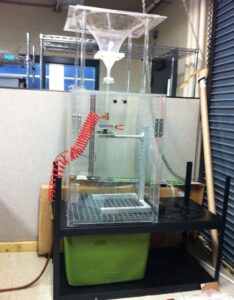
As a Senior Design project, our team’s goal was to design and build an abrasive/erosive wear test rig for John Deere. The rig will be used to test material performance against wear from multiple media such as crops, soils and other small particles. The test rig must have the capability of easily varying the media velocity/flow rate and the media/test material incident angle. A load cell should be placed on the fixture holding the 600 g material coupon so that impact forces can be measured. The fixture should be designed so that the material coupons can be easily changed. The machine will be restricted in size (5’x5’x door height) and will have to be enclosed for particle containment. Parts of the machine that handle wear media should be transparent allowing for particle interaction to be viewed. The test rig will have a hopper where the material is fed into. The hopper should be equipped with a load cell or level indicator to indicate how much material is in the hopper. Along with delivering the media there should be an easy way to remove it from the enclosure during or after testing. The outputs of the load cells will be read by a data acquisition system belonging to John Deere. The students are to coordinate the sensor output requirements with John Deere. The test stand will also incorporate a fluid delivery system that will deliver water or salt water to the rest samples to introduce corrosion. It would be desirable for the system to utilize 120 V power, but higher voltages are available.


